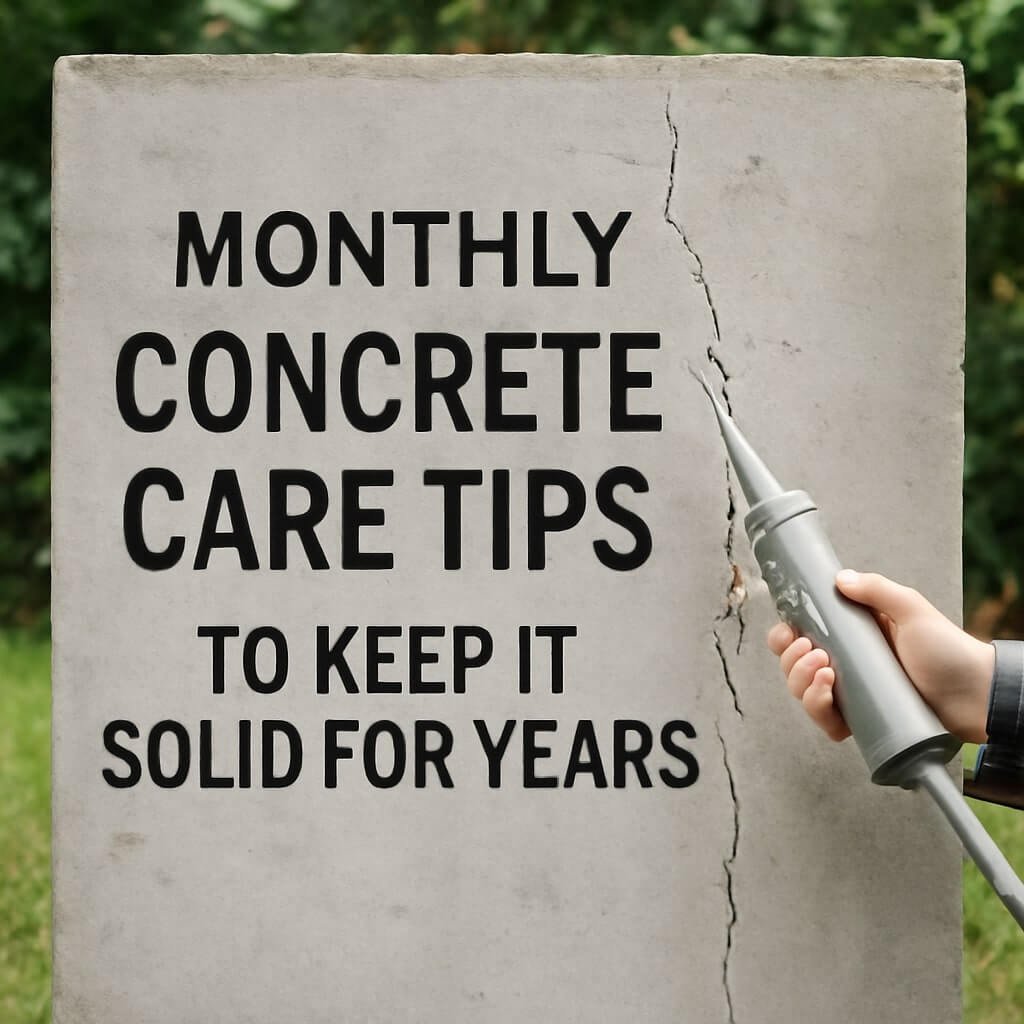Concrete is everywhere—from your driveway and sidewalks to patios and building foundations. While it’s known for its strength and durability, concrete still requires regular care to keep it solid and looking great over the years. Monthly concrete care is essential to prevent costly damage and extend its lifespan. This article shares 20 expert monthly concrete care tips that help you maintain your concrete surfaces efficiently, ensuring they remain strong and beautiful for decades.
Understanding Concrete: Why Proper Care Matters
Concrete is a mix of cement, water, and aggregates like sand and gravel, creating a strong but porous surface once it cures. Because it’s porous, concrete can absorb moisture and chemicals, which leads to common problems like cracking, scaling, and staining. Without proper maintenance, these issues worsen over time, compromising structural integrity.
Regular monthly care addresses minor issues before they escalate and protects your investment. Maintaining concrete properly also saves money by reducing the need for expensive repairs or replacements.
Monthly Inspection: Your First Step to Longevity
The foundation of concrete care is a thorough monthly inspection. This proactive step helps catch issues early and plan timely repairs.
Identifying Cracks and Surface Damage
Small hairline cracks are common but should never be ignored. Look for cracks that widen or lengthen, as they indicate deeper problems like settling or freeze-thaw damage. Surface damage like spalling (flaking) or scaling (surface peeling) signals water infiltration or poor finishing during installation.
Checking for Water Damage and Stains
Moisture can seep into concrete, causing efflorescence—white, powdery deposits on the surface—and dark stains from mold or algae. Early identification allows you to treat these issues before they cause structural harm.
Cleaning Concrete Monthly: Best Practices
Cleaning concrete regularly removes dirt, oils, and contaminants that degrade its surface. Follow these best practices for effective and safe cleaning.
Using Pressure Washers Safely
Pressure washers are powerful tools for cleaning concrete, but can damage surfaces if used improperly. Always use a wide spray tip, maintain a safe distance (at least 12 inches), and avoid lingering too long on one spot.
Removing Tough Stains and Efflorescence
For oil stains, use degreasers formulated for concrete. Rust stains can be treated with specialized removers, while efflorescence often washes away with a diluted vinegar solution or a mild acid cleaner designed for concrete.
Sealing Concrete Surfaces Every Month
Sealing is a critical step in concrete care, creating a protective barrier that repels water, chemicals, and stains.
Choosing the Right Sealant for Your Concrete
Sealants vary widely—acrylics, epoxies, and penetrating sealers each offer unique benefits. Acrylic sealants are great for aesthetics and ease of application, while penetrating sealers provide deep protection against moisture without altering appearance.
How to Apply Concrete Sealant Properly
Apply sealant on a clean, dry surface. Use a roller or sprayer for even coverage and avoid heavy application, which can cause bubbling. Follow manufacturer’s drying times carefully for best results.
Repairing Concrete Damage Promptly
Ignoring damage can cause it to worsen dramatically. Addressing issues like cracks or holes promptly extends your concrete’s lifespan.
DIY vs Professional Repairs: What You Should Know
Small cracks and surface chips can often be repaired with DIY kits available at home centers. However, for structural cracks or extensive spalling, hiring a professional ensures the repair is durable and safe.
Preventing Common Concrete Problems
Prevention is always better than a cure. Implement these tips to avoid frequent concrete issues.
Proper Drainage and Moisture Control
Standing water is concrete’s worst enemy. Ensure proper slope and drainage around concrete areas to keep water from pooling. Consider adding gutters or drainage systems if needed.
Avoiding Chemical Damage
Chemicals like de-icers and harsh cleaners can degrade concrete. Use safer alternatives like sand for traction in winter and gentle cleaners year-round.
Seasonal Adjustments to Monthly Concrete Care
Concrete care isn’t one-size-fits-all—seasonal changes require adjustments.
Winter Care Tips for Concrete
Freeze-thaw cycles cause concrete to crack. Keep surfaces dry, remove snow promptly, and avoid using rock salt; opt for sand or calcium magnesium acetate instead.
Summer Care Tips for Concrete
High heat can cause concrete to dry too quickly, leading to cracking. Keep concrete moist after sealing and avoid heavy use during peak heat hours.
Tools and Products Every Concrete Caretaker Should Have
Equip yourself with the right tools for monthly maintenance:
| Tool/Product | Purpose |
|---|---|
| Pressure Washer | Cleaning dirt and debris |
| Concrete Sealant | Protection from moisture and stains |
| Crack Filler | Repairing minor cracks |
| Degreaser/Cleaners | Removing oil and stains |
| Concrete Patching Kit | Filling holes and surface damage |
| Broom and Mop | Routine cleaning |
Frequently Asked Questions (FAQs)
How often should I seal my concrete surfaces?
Can I use household cleaners on concrete?
What causes concrete to crack?
How do I prevent efflorescence?
Is pressure washing safe for all concrete types?
When should I call a professional for concrete repair?
Conclusion: Maintaining Your Concrete for Decades to Come
Consistent monthly care is your best strategy to keep concrete strong and attractive. By inspecting, cleaning, sealing, and repairing regularly, you protect your investment and extend your concrete’s lifespan for years, sometimes even decades. The effort you put in today prevents costly problems tomorrow and preserves the solid foundation beneath your home or business.

